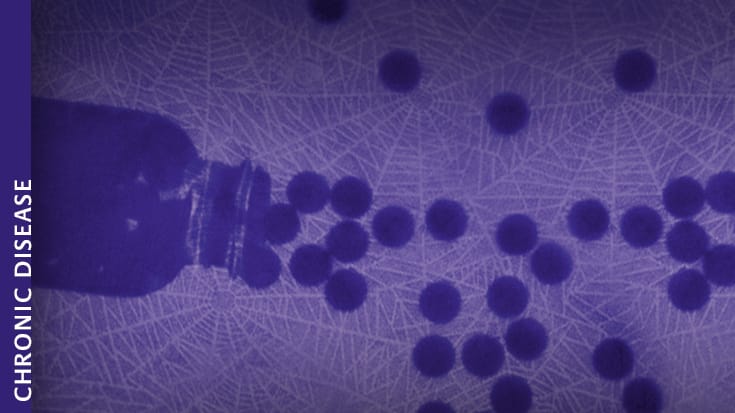
The federal government established the Hospital Readmissions Reduction Program (HRRP) to reduce the number of people with specific diagnoses, including COPD, who end up back in the hospital within 30 days of discharge.
That concept is tailor-made for the respiratory therapist. As the lung health experts in their facilities, they have the knowledge and expertise to help patients address the issues that often trap them in the revolving door of readmissions. Since the HRRP went into effect — and indeed, in some cases even before — they have stepped up to staff readmissions reduction programs to keep chronic lung disease patients, particularly those with COPD, at home whenever possible.
Six of them share their experiences with us in this story.
A COPD Care Pathway
The COPD Readmissions Project went live at Maine Medical Center in Portland on Jan. 18, 2016, implemented in large part as a response to the HRRP penalty program that went into effect about the same time.
“A multidisciplinary workgroup made up of doctors, respiratory therapist navigators, COPD pharmacists, care managers, nurses, discharge planners, and others worked together to create a COPD Care Pathway,” said Terry Comiskey, MBA, RRT, RRT-ACCS, CPFT, director of pulmonary service and respiratory care. “That pathway has now grown to include provider education, inpatient COPD scorecards, EPIC order sets and communication tools, patient education tools, COPD Action Plans, and a number of other related systems and program materials.”
RTs working as COPD educators are the primary point of contact with patients. Since they work under a COPD Pathway protocol, they can place specific medication and consult orders. They can also provide other services that higher-level providers typically handle.
It has all had a positive effect on the bottom line. Before the program went into effect in 2016, the COPD readmissions rate was a little over 17%. By 2020 it had dropped to 11%. Comiskey estimates that the cost of inpatient COPD care at Maine Medical Center decreased by about $1.5 million by 2019. Not only that, but the number of patients admitted with COPD exacerbation is down as well.
Comiskey credits their success to —
- The RT team’s ability to provide cohesive, personalized, in-house education to patients covering the disease process and how it can be effectively managed and controlled.
- An assessment of the patient’s overall capabilities for self-treatment, including insurance coverage, ability to afford medications, individual social situations, and the patient’s physical capabilities.
- The camaraderie that has developed between the various members of the health care team involved in the readmissions reduction process.
Transitional care model
Readmissions reduction went on the radar screen at Lexington Medical Center in West Columbia, SC, around 2016, according to Darlene Fry, RRT, RRT-NPS, CPFT, director of pulmonary and neurodiagnostic services.
“My team and I researched and visited other facilities that utilized chronic disease management programs and reviewed outcomes,” said Fry, ultimately presenting a transitional care model to administration.
The program’s goals are to reduce COPD readmissions and mortality rates through the provision of patient education, including medication administration, home oxygen therapy, and an individualized care plan.
“We also advocated that a respiratory therapist was most equipped to fill the role of navigator for COPD,” she continued. As a result, the navigator came on board in August and built the program with the other team members. Patients were ready to be seen by October.
While the program has only slightly impacted readmission rates, Fry believes it has paid off in other ways.
“The big win is that we are addressing patient needs before discharge, the patient is equipped to manage their disease post-discharge, and has a relationship with the navigator that extends to follow-up phone calls,” she said. “We have also increased pulmonary rehab referrals.”
Fry credits their success to —
- An increase in pulmonary rehab referrals and a screening spirometry program at primary care physician practices to facilitate the early identification of lung disease.
- A COPD education book for patients that includes disease education, inhaler descriptions with photos, and smoking cessation information.
- COPD Toolkits, supplied by the hospital foundation, to give to patients at discharge; they include a folding bag similar to a hanging cosmetic bag to hold inhalers and accommodate a weekly pill holder, MDI spacer, pulse oximeter, and COPD Action Plan magnet.
Complete education and discharge process
St. Joseph’s Hospital in Tampa, FL, has had a readmissions reduction program in place for five years now, said Maria Daniels, BS, RRT, pulmonary patient navigator for the program.
“We were challenged to cut our COPD readmission rates, and the program was created along with a position for a pulmonary patient navigator,” she said. As that navigator, she was charged with addressing and establishing a complete education and discharge process for the organization’s COPD population.
While the program targets all the COPD patients in the hospital, it especially zeroes in on those considered at high risk for readmission. Daniels spends a considerable amount of time with each of them, reviewing normal lung anatomy and physiology, physiologic changes caused by COPD, and medications to treat the condition. She goes over proper device techniques, how to tell the difference between an exacerbation and just a bad day, smoking cessation offered by Tobacco Free Florida, and oxygen use as well.
“When applicable, I recommend referrals for pulmonary rehabilitation and PFT testing,” she said. She also serves as a liaison to physicians and discharge planners to ensure proper length of stay, adequate education, and safe discharge. Bedside RTs assist by reinforcing the education with these patients once per shift.
The hospital has seen a significant downward trend in COPD readmissions over the past three years. For example, in 2018, the standardized readmission ratio (calculated by comparing the number of readmissions observed with the number expected) was 1.22. By 2019 it had dropped to 0.90, and in 2020 it came in at 0.85.
“This is looking at 65 and older, and all-payer mix,” she said, but notes a similar reduction has been seen across all age groups as well.
Daniels credits their success to —
- Extensive, comprehensive education, including the use of the Zones for COPD Management tool, a review of medications and their proper use, and an emphasis on how patients can self-manage at home and know when it is time to go to the ER.
- Collaboration with other disciplines on the team, such as physicians, nurses, case managers, social workers, pharmacists, and home health.
- Family support services that ensure the home environment is conducive to supporting the patient’s recovery.
- Weekly multidisciplinary team meetings to discuss difficult cases and current readmissions, including a root cause analysis of each case.
Long-running program
Sanford Medical Center in Fargo, ND, has addressed the need for COPD disease management for 14 years.
“Our inpatient COPD care program began the planning phase in 2007, with the goals of reducing cost and improving quality of care,” said Becky Anderson, RRT, manager, disease management. “At that time, we knew nothing about the future CMS Hospital Readmissions Reduction Program.” Instead, they simply wanted to provide better care to patients.
When it became clear that the HRRP was on the way, they refocused their efforts specifically on reducing readmissions.
“Work on readmissions reduction began in 2009 when our administrators pulled together an interdisciplinary team to plan for the launch of HRRP in 2012,” Anderson said. ”I was part of that planning group.”
With 14 years of outcomes under their belt, she and her colleagues offer solid evidence of how these kinds of programs can benefit patients and hospitals alike. Cost per case went down almost immediately, and within a year, they posted a positive net margin. Moreover, it has never again strayed into negative territory.
“We went from an average negative net margin of $615 per patient stay in 2006/2007 to an average positive net margin of $1,400 per patient stay,” she said — despite North Dakota having one of the lowest reimbursement rates in the nation.
The readmission rate, which was 26% at the outset, was cut in half within six months and has been as low as the single digits at times.
These days, the program sees about 300 patients a year who are coded with COPD exacerbation. Still, they also touch many other cases, including those with heart failure, pneumonia, and even COVID-19. Adherence to evidence-based care for COPD exacerbations stood at 56% at the beginning of the program. Now it’s in the 90th percentile.
Anderson credits their success to —
- Aligning the program with organizational goals and strategic initiatives and addressing all the disciplines involved with audience-specific conversations.
- Hiring RTs as COPD navigators to facilitate the work of the interdisciplinary team to improve overall COPD outcomes.
- Constant efforts toward quality improvement based on serving patient needs and providing safe transitions of care.
Education takes center stage
Cody Regional Health in Cody, WY, has also seen success with COPD readmissions reductions, although the pandemic has had an impact.
According to Lori Arnold, MS-HSA, RRT, Cody implemented the program in January of 2017 after reviewing similar programs in Wyoming and throughout the U.S. to reduce readmissions and help their patients stay healthier.
“Our program was initiated based on a metric that was controllable, which is the education of hospitalized patients and their family,” said Arnold, who serves as cardiopulmonary/home oxygen director. ”By educating patients, we knew it would ultimately impact our readmission rate.” As a result, RTs have primarily driven the program.
Arnold says the COPD readmission rate decreased from 11.9% in 2017 to 7.3% in 2019, but the pandemic has increased those rates. However, she believes it’s important to note the increase has primarily been driven by cases where COPD was the secondary rather than primary diagnosis.
Arnold credits their success to —
- Involving patients and families in the education process.
- Conducting follow-up calls with patients not referred to home health.
- Implementing a program to assist with medication costs and ensuring all patients leave the facility with a 30 day supply of their medications and extensive instruction on how to take them.
- Using home health and community EMS to assist with follow-up, along with the hospital’s home oxygen provider.
Rising rates motivate change
At WellSpan York Hospital in York, PA, Transitional Care Coordinator Alicia Yohe, BS, RRT, RRT-ACCS, said rising COPD readmission rates, along with a perceived gap in care after discharge, were the major motivators for their program implemented in 2019.
“Patients were having difficulty managing their care and did not have the appropriate resources,” she said. “Our organization developed a multidisciplinary approach to improve the care of patients with chronic lung disease.”
Respiratory therapists have been heavily involved through a pulmonary navigation program that was developed and is exclusively led by RTs.
“Our first year was extremely successful,” Yohe said. “We increased our CMS star rating from a one to a five and reduced our COPD readmission rates to below 20% for all payors.”
Like at Cody Regional up in Wyoming, however, COVID-19 has complicated things. The hospital saw a dramatic increase in COPD readmission rates during the pandemic. Yohe says the team is currently investigating the issue and working to eliminate or improve on the contributing factors so that the hospital can once again see the success it saw initially.
Yohe credits that success to —
- A multidisciplinary approach that speaks to the fact that the complexity of chronic lung disease treatment demands the skill and expertise of all health care teams.
- Determination to keep going throughout the difficulties and the ability to recognize failures as opportunities to improve.
- A willingness to learn from others and model the program after facilities that have already demonstrated success in reducing readmissions.
The post-acute care perspective
Gary Y.G. Wong, MBA, RRT, offers a unique perspective on readmissions reductions. As director of respiratory services at Islands Skilled Nursing and Rehabilitation in Honolulu, HI, his mission to keep his residents out of the acute care hospital has primarily focused on reducing the incidence of ventilator-acquired pneumonia (VAP).
“In the post-acute care environment, it is common practice to have an established hospital readmissions program not only for the quality of care but to ensure that you continue to have a good relationship with the referring hospitals,” Wong said. “A key metric is the prevention of ventilator-acquired pneumonia.”
Through a process involving implementing a closed ventilator circuit, closed suctioning catheter, administering cough assist through the VOCSN ventilator, and administering aerosols through an inline Aerogen nebulizer, Islands was able to reduce its readmissions for VAP to zero during 2020.
Wong notes they also had success with secretion management by instituting a daily regimen of continuous heated humidification, along with mechanical insufflation-exsufflation and continuous high-frequency oscillation to noninvasively control pulmonary secretions.
“With the reduction of VAP and re-hospitalizations, we are able to successfully wean and trach decannulate patients while concurrently having multidisciplinary rehabilitation and decrease the total average length of stay by 30 days in our facility,” Wong said.
Wong credits their success to —
- The use of continuous bedside respiratory monitoring of oxygen saturation, heart rate, and respiratory rate, along with continuous capnography when needed to catch problems before they end up in a hospital admission for respiratory failure or VAP.
- Use of the Masimo SafetyNet system with remote handheld monitoring to help identify patients who require a respiratory assessment and intervention by the RT to avoid an unplanned transfer to the ER.
- A patient-centric care plan that allows RTs to spend time at the bedside delivering patient education, performing respiratory muscle training, coaching, and encouraging patients to alleviate their anxiety while weaning and rehabilitating in the facility.
In their own words
What advice do these therapists have for their colleagues who have yet to implement a program to reduce readmissions for chronic lung patients? We’ll let them tell you, in their own words —
The best advice we can give is to find a “champion” of the cause who believes in the importance of initiating such a program and who has the administrative influence to be able to make it happen. Leadership is always important, and we were fortunate enough to have good leadership for our program on multiple levels, from a pulmonologist who originally “championed” our program, to engaged administrative and respiratory therapy departmental leaders, all of whom believed in the cause and were able to clearly define the goals of the program and bring together a team of dedicated RTs, thereby getting the program up and running. — Terry Comiskey
There are some great transitions of care models for COPD out there. Do some research and find what would work at your facility. Engage all disciplines and have physician involvement from inpatient, pulmonary, and physician practices. — Darlene Fry
This is the right thing to do for our patients! Take the time to interview the patient, find out their needs, and meet their demands. We found the key to success is assessing each patient’s needs and then customizing their discharge care plan to optimize their success. This ultimately contributes to positive patient outcomes and reduced hospitalizations. — Maria Daniels
Be proactive and ask to be involved. Become the content expert in pulmonary/respiratory disease and evidence-based care. Understand the key organizational players and what’s important to them. Know your worth and be ready to explain how RTs can successfully impact readmissions based on the needs of the organization. Reach out through AARConnect communities to network with others who have experience. — Becky Anderson
Don’t set a goal to reduce readmissions, but instead set a goal to have your patient base educated while in the hospital. Our goal is to educate 95% of the patients admitted with COPD as the primary or secondary diagnosis. Just by educating and empowering our patients in their own health care, our readmission rates have remained far below the national average. — Lori Arnold
Show your skills. RTs have much to offer in this area. Market your department and show how your team can contribute to hospital or outpatient programs and outcomes. Keep abreast of relative information in the field and reach out to other hospitals for ideas when developing a program. Be willing to collaborate and seek out that collaboration with multiple teams within your organization. — Alicia Yohe
My advice for other RT departments in post-acute care is to allow adequate staffing ratios so that your therapists can work closely with their patients to gain their trust and cooperation to be compliant with their respiratory care plan and not refuse to participate in the rehabilitation. Use the available respiratory monitoring technologies to be able to have your staff get real-time clinical data to make critical decisions and recommendations for the care plan and/or interventions. Lastly, it is very achievable to prevent hospital readmissions from VAP if you employ the use of the technologies for successful pulmonary secretion management. — Gary Wong
Ready to learn more about readmissions reduction programs? Join the COPD Best Practices Community on AARConnect to network with therapists who have already developed these initiatives. Membership in the AARC’s Ambulatory and Post-Acute Care Specialty Section can connect you with leaders in the post-acute care setting who are tackling readmissions on that front as well.
Email newsroom@aarc.org with questions or comments, we’d love to hear from you.














